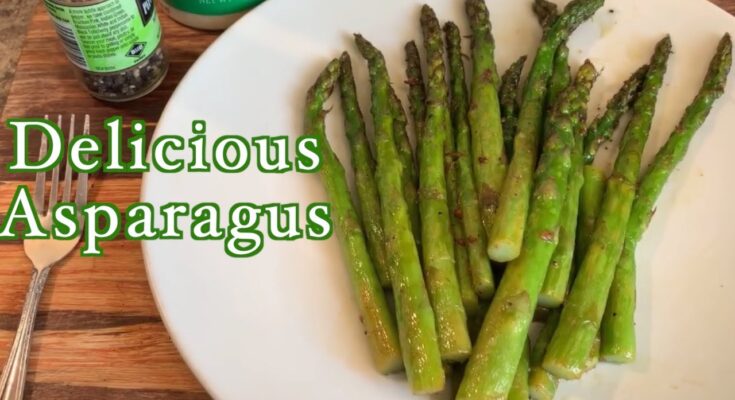Best Asparagus Recipe: Asparagus isn’t just another green veggie. It’s a superfood in disguise. Packed with vitamins A, C, E, K, and B6, along with folate, iron, copper, calcium, protein, and fiber, it’s like a health jackpot on your plate. This green spear is low in calories but rich in antioxidants, making it an ideal addition to any meal. And the best part? It tastes amazing when cooked right.
Asparagus is also a natural diuretic, which means it helps flush out excess salt and fluid from your body—perfect for those watching their blood pressure or dealing with bloating. Its high fiber content also promotes digestive health and keeps things moving smoothly in the gut. It’s like nature’s own detox food that doesn’t skimp on flavor.
Choosing the Best Asparagus at the Store
When you’re standing in the produce aisle trying to pick the best asparagus, don’t just grab the first bundle you see. Look for stalks that are firm and straight with tightly closed tips. The brighter the green, the better. If it looks limp or mushy, move on. And check the bottom of the stalks—if they’re dry or cracking, that’s a red flag.
Size-wise, don’t get too hung up. Thin asparagus tends to be more tender, while thicker stalks have a meatier texture—both work great depending on your preference or cooking method. Just make sure whatever size you choose is consistent, so they cook evenly.
Ingredients Needed for the Best Asparagus Recipe
Basic Ingredients List
To whip up this delicious and simple asparagus recipe, you’ll need just a handful of pantry staples:
- 1 bunch of fresh asparagus (about 1 pound)
- 2 tablespoons of olive oil
- 2 garlic cloves, minced
- Salt to taste
- Freshly ground black pepper
- Juice of half a lemon (optional)
That’s it. Simple, clean ingredients that bring out the natural flavor of asparagus.
Optional Add-ons for Extra Flavor
Want to take things up a notch? Add these:
- Freshly grated Parmesan cheese
- Crushed red pepper flakes for a kick
- Balsamic glaze for a sweet-tangy finish
- Toasted almonds or pine nuts for crunch
- A sprinkle of fresh herbs like thyme or parsley
These extras aren’t required, but they can add layers of texture and flavor that’ll have people asking for your recipe.
Step-by-Step Asparagus Recipe
Step 1: Washing and Trimming the Asparagus
Start by rinsing the asparagus under cool running water to remove any grit or dirt. Then comes trimming. Hold a stalk and bend it gently—the asparagus will naturally snap where the woody end meets the tender part. Use that as your guide to trim the rest. This simple trick ensures you’re only cooking the best part of the veggie.
You can also line them up and cut off the ends all at once, but snapping each individually is oddly satisfying and foolproof.
Step 2: Choosing the Cooking Method
There are multiple ways to cook asparagus, and the best method depends on your taste and mood. Let’s break them down:
Roasting
Roasting brings out the natural sweetness and adds a slightly crispy texture. Preheat your oven to 400°F (200°C). Toss asparagus with olive oil, salt, pepper, and garlic. Spread on a baking sheet and roast for 15-20 minutes, shaking the pan halfway through. Finish with lemon juice or Parmesan.
Steaming
Want to keep it super healthy? Steam the asparagus for 5-6 minutes until bright green and just tender. This method preserves nutrients better and keeps the texture crisp-tender. Don’t overdo it though—overcooked asparagus turns mushy fast.
Sautéing
Heat a skillet over medium heat with olive oil or butter. Toss in garlic, let it sizzle, then add asparagus. Cook for 8-10 minutes, stirring occasionally. The spears will get nicely browned and caramelized on the edges—perfect with a splash of lemon at the end.
Step 3: Seasoning the Asparagus
Seasoning is the magic that brings your asparagus to life. Once your asparagus is trimmed and ready to go, don’t hold back on the flavor. A drizzle of olive oil helps it roast or sauté beautifully while keeping it from drying out. Add a generous pinch of kosher salt and a few grinds of fresh black pepper to start.
But why stop there? Minced garlic adds a punch of aromatic depth. Want a touch of heat? Sprinkle on some crushed red pepper flakes. For a zesty twist, squeeze a bit of lemon juice right before serving—it brightens up the flavors like nothing else. Feeling indulgent? Shave some Parmesan over the top while it’s still hot so it melts just slightly. Your taste buds will thank you.
If you’re feeling adventurous, consider a dusting of smoked paprika or even a splash of soy sauce or balsamic vinegar for a unique edge. The best seasoning? Whatever makes your mouth water.
Step 4: Cooking Time and Temperature
Perfect asparagus isn’t just about the ingredients—it’s about timing and temperature. Get this wrong, and you’ll end up with mushy stalks or ones that are too raw in the center.
Here’s a quick cheat sheet:
- Roasting: 400°F (200°C) for 15-20 minutes.
- Sautéing: Medium heat for 8-10 minutes.
- Steaming: Medium-high heat for 5-6 minutes.
The key is to cook until the asparagus is bright green and tender but still has a slight bite. Don’t walk away while it’s cooking—this veggie goes from perfect to overdone fast.
To test doneness, just pierce a stalk with a fork. It should slide in easily but not too easily. If the asparagus bends too much or looks dull in color, you’ve probably gone a bit over.
Step 5: Garnishing and Serving Suggestions
Now for the fun part—making your asparagus look and taste like a restaurant-quality side dish. Right before serving, add any final garnishes to elevate your plate. A grating of fresh lemon zest or Parmesan cheese can do wonders. If you roasted it, a drizzle of balsamic glaze will make it sing.
For a crunch factor, top it off with toasted slivered almonds or crushed pistachios. If you’re serving a fancy meal, add a poached egg or a sprinkle of truffle salt. This humble veggie can easily hold its own as a showstopper.
Pair it with grilled salmon, roasted chicken, or even add it to pasta or salad. Leftovers (if any!) can go into omelets, wraps, or stir-fries.
Tips for Perfect Asparagus Every Time
Common Mistakes to Avoid
- Not trimming the woody ends – This results in tough, chewy bites.
- Overcooking – Say goodbye to that bright green color and hello to mush.
- Crowding the pan – It steams instead of roasts, ruining texture.
- Skipping the seasoning – Asparagus needs a flavor boost, so don’t be shy with the spices.
- Ignoring consistency – Mixing thick and thin stalks? They won’t cook evenly.
Avoiding these mistakes can turn your asparagus from just okay to absolutely amazing.
How to Store Leftovers
If you’ve made too much (is that even possible?), store leftovers properly to keep them tasting fresh. Place cooked asparagus in an airtight container and refrigerate for up to 3 days. When reheating, use a skillet over low heat to retain its texture or toss it cold into a salad.
You can freeze it, too, but expect a change in texture. Blanch first, then flash-freeze on a tray before storing in freezer bags. Great for soups or casseroles later!
Health Benefits of Eating Asparagus
Vitamins and Minerals
Asparagus is like nature’s multivitamin. It’s high in folate, crucial for cell growth and especially important during pregnancy. Vitamin K supports bone health and blood clotting, while vitamin C boosts your immune system. It’s also rich in antioxidants that help protect against free radicals.
What does that mean for you? Fewer sick days, stronger bones, and a little more energy in your day-to-day.
Digestive and Detox Support
Asparagus contains inulin, a prebiotic fiber that feeds the good bacteria in your gut. That helps with digestion, reduces bloating, and can even support mental clarity. It also acts as a natural diuretic—flushing out excess fluid and supporting kidney function.
In other words, asparagus is doing way more for your body than you ever imagined. All that from a side dish? Yup.
FAQs about Best Asparagus Recipe
Q1: What’s the best way to cook asparagus?
The best way depends on your preference! Roasting, sautéing, and grilling bring out a nutty, caramelized flavor, while steaming or boiling keeps it tender and light.
Q2: How do I know when asparagus is done?
Asparagus is ready when it turns bright green and can be easily pierced with a fork but still has a slight crunch. Overcooking can make it mushy.
Q3: Should I peel asparagus before cooking?
Thicker stalks may benefit from peeling the lower third to remove toughness, but thin asparagus usually doesn’t need peeling.
Q4: How long does asparagus take to cook?
Cooking time ranges from 5 to 15 minutes depending on the method. Roasting usually takes 12–15 minutes, while steaming or boiling takes about 5–7 minutes.
Q5: Can I store leftover cooked asparagus?
Yes! Store it in an airtight container in the fridge for up to 3 days. Reheat gently to avoid overcooking.
Q6: What flavors pair well with asparagus?
Lemon, garlic, Parmesan cheese, olive oil, balsamic vinegar, and butter all complement asparagus beautifully.
Conclusion
Asparagus might seem like a simple vegetable, but when cooked right, it becomes a flavorful, nutritious superstar on your plate. Whether roasted, steamed, or sautéed, it’s all about using fresh ingredients, adding the right seasoning, and paying attention to cooking time. With a few tips and tricks, anyone can master the art of cooking asparagus. So the next time you’re planning dinner, don’t overlook this green spear—it’s easy to make, endlessly versatile, and ridiculously delicious.



